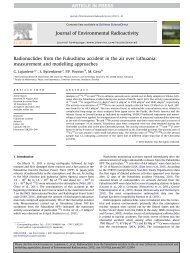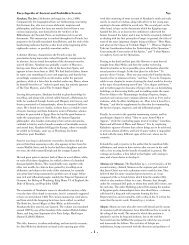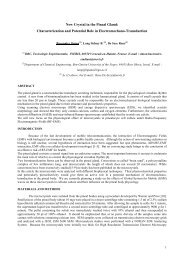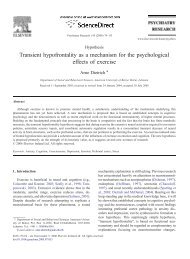Psychology of Terrorism - National Criminal Justice Reference Service
Psychology of Terrorism - National Criminal Justice Reference Service
Psychology of Terrorism - National Criminal Justice Reference Service
Create successful ePaper yourself
Turn your PDF publications into a flip-book with our unique Google optimized e-Paper software.
technology and science.-Although most <strong>of</strong> the imprisoned terrorists objected to being isolated from their comrades andrefused to have contacts with “normal” prisoners, Mahler found such associations helpful. His“disputes with them moderated” his commitment to the terrorist cause and liberated his thinking. Hebegan to oppose terrorist attacks and switched to the Maoist communist camp. Mahler was“excommunicated” from the RAF which he had founded only a few years earlier.-The original goal <strong>of</strong> RAF had been to start a “socialist” revolution to fight humiliation <strong>of</strong>Germany’s past and the country’s entanglement with the USA. After the jailing <strong>of</strong> members <strong>of</strong> theBaader-Mainh<strong>of</strong> group, the emphasis shifted to freeing prisoners.-The German terrorist movement appears to be multicasual phenomenon.-Horst Mahler, the founder <strong>of</strong> the RAF, provides valuable insights into the making <strong>of</strong> a terrorist.-Horst’s turning away from the extreme right was not only due to the Nazi regime’s defeat butprobably motivated by his objections to his father’s ideologies.-The terrorists became dependent on each other for support and considered the outside world an evilsystem to be eliminated.19. Birrell, D. (1972). Relative deprivation as a factor in conflict in northern Ireland. Sociopolitical Review,20(317-343).Call Number: Editor's Annotation: The author uses the concept <strong>of</strong> relative deprivation (a group seesitself at a disadvantage when it is compared to some other reference groups) to explain conflictsbetween Catholics and Protestants in Northern Ireland. It argues that Catholics historically haveperceived themselves to be at a disadvantage and that this perception is supported by objective data.Runicman's three areas <strong>of</strong> inequality are used: economic, social and political. Author suggestsrelative deprivation can lead to violence in at least two ways: (1) via frustration-aggression (Gurr) or(2) via "creative rioting" (Geschwender) rioting accompanied by stated political demands andattempts to occupy or control an area. The author’s conclusion is that relative deprivation is a causalfactor on Northern Ireland violence and because the inequality is real, the only reasonable remedy toviolence is correcting the lack or equality.20. Bjorgo, T. (1997). Racist and right wing violence in Scandinavia: patterns, perpetrators, and responses. OlsoTano Aschehoughs Fonteneserie.Call Number: Editor's Annotation: This book began as the author’s dissertation. It focuses on thediversity in racist and right wing violence in Scandinavian countries (Norway, Sweden, &Denmark), with an emphasis on violence toward immigrants. Although some anti-immigrantviolence is committed by racist gangs, much <strong>of</strong> it is done by young gangs that subscribe to nocollective ideology.-The author describes Helmut Willams’ classification <strong>of</strong> perpetrators <strong>of</strong> racial violence: ‘ideologicalactivists’, ‘xenophobes’, ‘criminals’ and ‘fellow travelers’. He classifies the groups themselves aseither ‘national democrats’ (anti-immigration activists) or ‘racial revolutionaries’ (neo-Nazis). Thetext provides data on trends <strong>of</strong> the relevant <strong>of</strong>fenses in each country. Sweden tends to have moreXenophobic violence. Group dynamics factor significantly into these attacks and the waves andpatterns cannot be completely explained by macro-social factors. Younger gang members(adolescents) seem drawn to racist gangs and their anti-immigrant activity just to be part <strong>of</strong> a group.Young adult gangs (17-25) tend to be economically deprived and blame immigrants for their plight.What will facilitate violence with the group is prior familiarity with vandalism and violence, accessto weapons, and proximity to hated targets. At the community level, law enforcement neglect,media publicity and a tacit anti-immigrant community sentiment also tend to breed such incidents.The revolutionary groups are driven by the notion <strong>of</strong> war against the Zionist occupied governmentand frenzied by “white power music.” In general, in racist groups racism tends to the result ratherthan the cause <strong>of</strong> group affiliation. The more individuals become included and socialized within thegroup (and insulated from extra-group influences), the more difficult it becomes to leave. Theauthor discusses the differing dynamics in Scandinavian groups adhering to “anti-Muslim” versus“anti-Jewish” conspiracy theories. He concludes with a lucid and insightful summary <strong>of</strong> the corevalues areas over which racist groups, communities, the media, etc. all vie for control: ideology andimmigration politics, identity, scarce resources, sexuality, territory, and security. An excellent workon the phenomenon <strong>of</strong> racist violence, with insights that extend well beyond the Scandinavian














